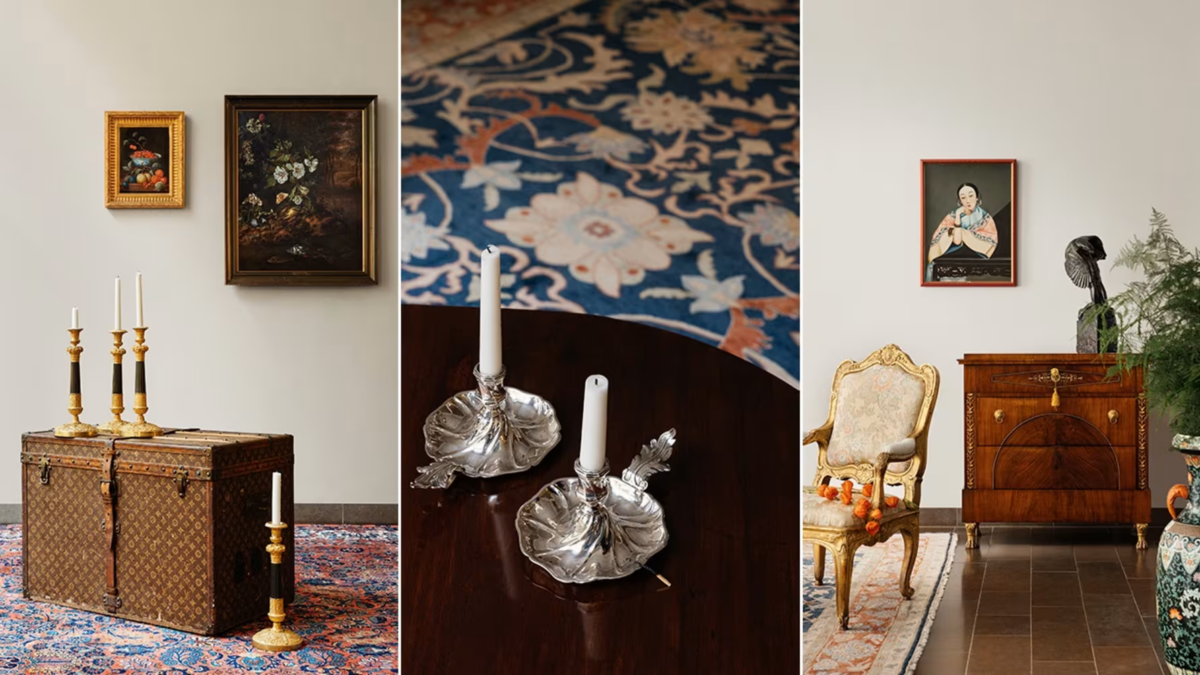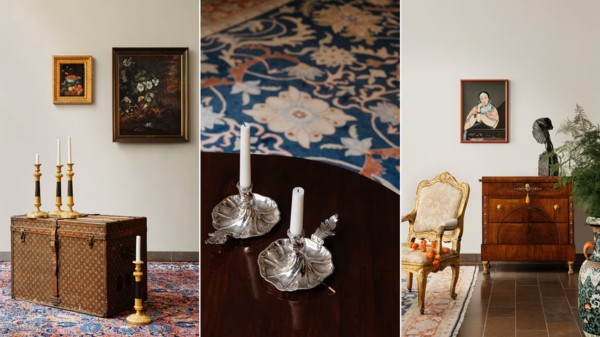The Arts and crafts department’s highlights for Fine Art and Antique auction
Royal provenance, rare porphyry and loving gifts – this autumn’s Fine Art & Antiques offers many historic items rarely seen on the auction market. The Fine Art auction will be held on December 5–6 at Nybrogatan 32 in Stockholm, the show will run between November 29 and December 4. The catalog is published in its entirety online. But even now, Markus Anderzon, specialist in antique furniture and handicrafts, can present some of his selected highlights.
– It feels especially fun to publish an auction that contains this type of unique items, these are things that are rarely offered on the market and that are exciting to only be able to display here in our premises. Many of the items have museum qualities and yet are available for anyone to purchase. In addition, with very detailed provenance, something that gives the objects even more pulse.
Item provenance is a factor that has grown in importance in recent years. Stockholms Auktionsverk’s specialists have been able to see a general trend and development where precisely the importance of provenance weighs more and more heavily with buyers.
– You don’t want just any thing, you want the specific thing. During the 80s and 90s, provenance was not something that people attached much importance to, but now we notice that it has become much more essential. When there are inheritances or when collections are spread on the market via auction, it may be the last chance you have to document the objects’ background, so we take it very seriously. Our catalogs are part of the historiography of the objects, the work we put in now can make the object searchable in 200 years.
One of the arts and crafts department’s great highlights takes the form of a high-class Late Gustavian Stockholm work – a table pendulum made by the royal court chiseler and master belt maker Fredric Ludvig Rung (1758–1837). According to family tradition, Rung gave a table pendulum of this particular model to each of his daughters, this particular example he made for his third daughter Fredrika Ulrika Rung and has been passed down through four generations and then given as a gift to its current owner.
– This is undoubtedly a rare opportunity to acquire a piece of high-class Swedish arts and crafts history, which is further strengthened by its unbroken provenance, from the year of manufacture until today. The table pendulum is a clear example of the domestic manufacturing that quickly came about in the wake of the castle building project in Stockholm. Here we get concrete proof of the skill of the Swedish craftsmen, with the refined combination of beautiful Gammelklitt porphyry and high-class bronze mountings by Fredric Ludvig Rung, which form an exquisitely balanced whole of internationally comparable dimensions.
It is almost identical to the table pendant with Gammelklitt from the Elfdal Porphyry Works by Fredric Ludvig Rung which is part of the National Museum’s collections, and similar to the table pendant with Blyberg porphyry from the Elfdals Porphyry Works in the Nordic Museum’s collections. Through his international style and excellent quality, Rung was frequently employed by the royal family, as the first truly renowned Swedish master within his guild, he became an important player in the further development of burnt-gilt bronzes.
Porphyry in particular is a recurring material among the highlights of the auction. The rare material has been popular ever since the time of the pharaohs, thanks to the Romans, the shiny stone was also introduced to Europe – then exported from the Egyptian quarries. During the 4th century, imports were suspended, but this did not dampen demand. During the 16th century renaissance, the porphyry quarries had fallen into oblivion, people had simply forgotten where they were located once upon a time. Instead, they took old porphyry objects and reworked them according to prevailing ideals.
At the end of the 18th century, it became an exclusive stone – and a highly local natural resource – the reason for a large industrial investment in the then very poor area around Dalska’s Älvdalen. Elfdals Porphyrverk was founded in Älvdalen in 1788 by King Gustav III and established with a well-known board, to say the least, with members such as Carl August Ehrensvärd, Louis Masreliez, Johan Tobias Sergel and Carl Fredrik Fredenheim – Gustav III’s art agent in Italy. The production of the objects was initially limited and the porphyry much more difficult to work than expected. It was not until the time of Karl XIV Johan, when the new French crown prince had the porphyry work acquired in his son Oskar’s name, that the business began to flourish. It is also from this time that many of the catalog’s most prominent objects originate. Like the box with lid of Blyberg porphyry from the first quarter of the 19th century, a pair of table chandeliers of black Rännå porphyry from around the end of the 18th century, a pair of Late Gustavian Stockholm works in the form of candlesticks of Blyberg porphyry dated around 1800, as well as an urn in Tinguait from the second of the 19th century quarter – all with provenance from Elfdals Porphyrverk.
The porphyry objects were from the beginning works that belonged to the royal houses and the high nobility, for Sweden it was also a currency for trade exchange – Karl Johan exchanged porphyry for burnished gilded bronzes from Paris. The Swedish porphyry still maintains a high profile and recognition internationally. But this autumn’s Classical & Asian collection also includes a porphyry urn with southern European provenance. From the beginning of the 19th century sculpted Greek porphyry, the rare marble variety Lapis Spartanus to be precise.
– It is a significant object because it is made in such an odd type of stone, which seems to have been highly valued and admired already in antiquity. It existed in small pieces used for mosaics and details, but an object of this size is made from a larger block and that alone makes the object significant. Then, of course, it is always a little extra exciting with materials and objects that are framed by the wings of history in general, of Greece and Sparta in particular.
Historic wings from more northern latitudes wind around two of the auction’s items that bear royal provenance. Like the armchair with carved wood decor and birch frame that was given as a christening gift in 1758, by none other than Queen Lovisa Ulrika. The recipient of the gift was Fredrika Lovisa Sofia Giös, daughter of Countess Johanna Charlotta Posse who was also the queen’s maid of honor. When Queen Lovisa stood as godfather at the christening, this gift was thus handed over, in the form of an armchair – a so-called bergere en gondola – which was then passed down within the family to the current owner.
Add to that Prince Fredrik Adolf’s hunting rifle, a flint lock double barrel by well-known gunsmith Alexandre Chasteau. The gun is comparable to a very similar hunting rifle in the Livrustkammaren’s collection and purchased from Carl Robert Lamm’s collection. Prince Fredrik Adolf was King Adolf Fredrik and Lovisa Ulrika’s youngest son and brother of Gustav III and Duke Karl. Born in 1750, he was described as one of Europe’s most handsome princes, but was considered considerably weaker when it came to will and character. His legacy mainly revolves around his love affairs and wasteful lifestyle, but his interest in hunting and the preparation of his pleasure castle Tullgarn were tasks he must have taken very seriously. Markus Anderzon’s personal favorite items from this autumn’s Classical & Asian collection have connections to another well-known castle from the early 1800s.
– The very first issue of the catalog is my personal favorite. A pair of stools by Erik Öhrmark, they are of an extremely unusual model and a particularly exciting layer is added in that he is also behind the famous rocking chairs in Gustav III’s pavilion at Haga Castle. Öhrmark was a versatile chair maker and had a docile nature, he always managed to follow fashion and at the same time give proof of his great craftsmanship. These stools have an antique look, the saber-shaped legs come precisely from the Antiken chairs that were used in battles out in the desert – and the design of the legs was a way to prevent them from sinking into the sand. What is special about all of Öhrmark’s four objects – which are included in the auction – is that you can see the original gray color peeking out under the later painting and thus get a vision of their origin








